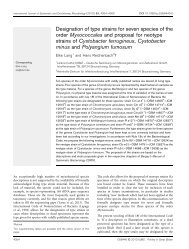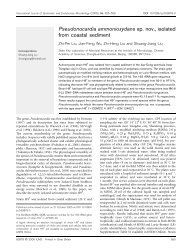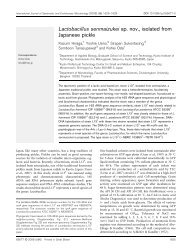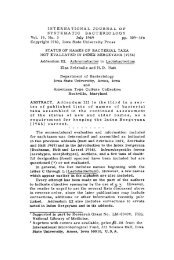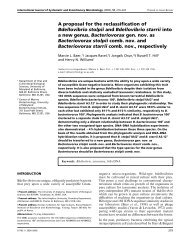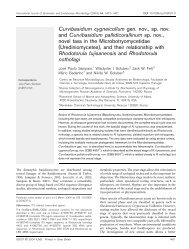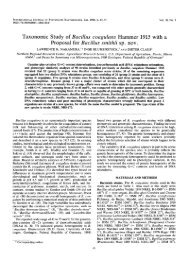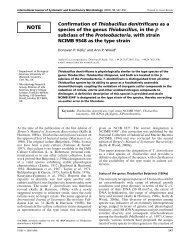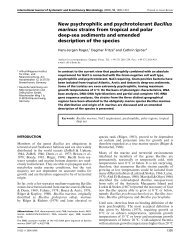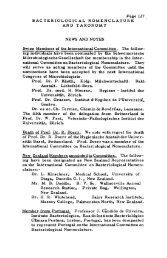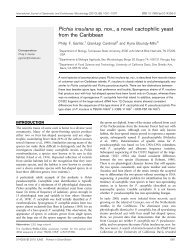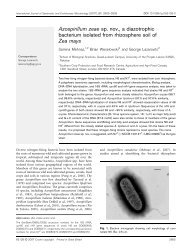Stenotrophomonas acidaminiphila sp. nov., a strictly aerobic ...
Stenotrophomonas acidaminiphila sp. nov., a strictly aerobic ...
Stenotrophomonas acidaminiphila sp. nov., a strictly aerobic ...
You also want an ePaper? Increase the reach of your titles
YUMPU automatically turns print PDFs into web optimized ePapers that Google loves.
under <strong>aerobic</strong> conditions. The classification of each strain as<br />
sensitive, not sensitive or intermediately sensitive to the<br />
antibiotic was done according to the disk manufacturer’s<br />
instructions (Sanofi Diagnostics Pasteur), based on the<br />
directives of the French antibiogram committee (Comite de<br />
l’antibiogramme de la Socie te Franc aise de Microbiologie,<br />
1997). The antibiotics tested corre<strong>sp</strong>ond to those presently<br />
recommended for Pseudomonas aeruginosa and other Gramnegative<br />
aerobes. They cover the different mechanisms of<br />
antibiotic action (inhibition of synthesis of peptidoglycan,<br />
proteins, nucleic acids and folate and disruption of membranes).<br />
CFA analysis. The CFA compositions of strains AMX 17 and<br />
AMX 19T and also those of collection strains were determined<br />
by Microbial ID, Inc., using the Sherlock Microbial<br />
Identification System software (MIDI Inc.). Prior to<br />
analysis, reference strains and isolates were cultivated in<br />
trypticase soy broth agar at 28 C for 24 h. CFA were<br />
extracted and analysed by following the instructions and<br />
standard procedures of Microbial ID, Inc. (Miller, 1982;<br />
Sasser, 1990).<br />
Nitrate and nitrite reduction. A preliminary examination of<br />
the ability of the strains to reduce nitrate and nitrite was<br />
performed by the traditional colorimetric procedure (Smibert<br />
& Krieg, 1994). This test consists of the addition, after<br />
incubation, to the culture medium supplemented with nitrate<br />
or nitrite, of sulfanilic acid and N,N-dimethyl-1-naphthylamine,<br />
which react with nitrite to produce a pinkred<br />
coloration. The presence of colour in the medium supplemented<br />
with nitrate is indicative of its reduction to nitrite,<br />
while an absence of coloration in the medium supplemented<br />
with nitrite is indicative of its reduction. In case no colour<br />
appeared in the medium supplemented with nitrate, zinc<br />
powder, which converts nitrate to nitrite, was also added in<br />
order to confirm that nitrate was reduced further than nitrite<br />
and did not remain in the medium. The ability of the strain<br />
to reduce nitrate was double-checked with the API 20 NE<br />
strips inoculated for biochemical analysis. Nitrate and nitrite<br />
reduction were later confirmed by inoculating, in each case,<br />
three tubes containing 10 ml of the following sterile medium<br />
(l−):51 gNaHPO ,11 g NaH PO ,50 gKHPO ,0229 g<br />
NH Cl; 0033<br />
<br />
g FeSO<br />
<br />
.7H O and<br />
<br />
3 ml of<br />
<br />
a trace<br />
<br />
metal<br />
solution<br />
<br />
(El-Mamouni<br />
<br />
et<br />
<br />
al., 1995). CH COONa.3H O<br />
(68 gl−, 50 mM) was used as the carbon<br />
<br />
source, while<br />
<br />
nitrate and nitrite were added as NaNO and NaNO at<br />
concentrations of 100 and 150 mM, sufficient<br />
<br />
to allow<br />
<br />
the<br />
oxidation of all the acetate. At these concentrations, neither<br />
nitrate nor nitrite appeared to produce significant inhibition<br />
of growth of strain AMX 19T. The medium was made anoxic<br />
by boiling under a flow of carbon dioxide, which also<br />
corre<strong>sp</strong>onded to the final atmo<strong>sp</strong>here of the tubes. With this<br />
mode of preparation, the pH of the medium after inoculation<br />
(10% vv) was around 7. The reduction of nitrate and nitrite<br />
was monitored by following their disappearance as well as<br />
the formation of N O in the gaseous phase and ammonium<br />
in the aqueous phase.<br />
<br />
Molecular nitrogen was not followed,<br />
since it was impossible to obtain an N -free atmo<strong>sp</strong>here by<br />
bubbling CO or other gases (i.e. helium).<br />
<br />
<br />
DNA base determination. The GC content of the DNA of<br />
strain AMX 19T was determined by HPLC at the ‘DSMZ’,<br />
with non-methylated λ phage DNA as the reference. Procedures<br />
for isolation and determination were from Cashion et<br />
al. (1977) and Mesbah et al. (1989).<br />
16S rRNA sequencing and phylogeny. Extraction of DNA<br />
from strains AMX 17 and AMX 19T, 16S rRNA gene<br />
<strong>Stenotrophomonas</strong> <strong>acidaminiphila</strong> <strong>sp</strong>. <strong>nov</strong>.<br />
amplification, purification and sequencing were performed<br />
by MIDI Labs. The 16S rRNA gene was amplified by PCR<br />
from genomic DNA isolated from bacterial colonies. Primers<br />
005F and 1540R (F, forward; R, reverse; Lane, 1991)<br />
used for the amplification of the full-length sequence (strain<br />
AMX 19T) corre<strong>sp</strong>ond to Escherichia coli positions 5 and<br />
1540 and primers 005F and 531R, used for the partial,<br />
500 bp sequence (strain AMX 17), corre<strong>sp</strong>ond to positions 5<br />
and 531. Amplification products were purified using Microcon<br />
100 molecular mass cut-off membranes (Amicon) and<br />
checked for quality and quantity by running a portion of the<br />
products on an agarose gel. Cycle sequencing of the 16S<br />
rRNA amplification products was carried out using Ampli-<br />
Taq FS DNA polymerase and dRhodamine dye terminators.<br />
Excess dye-labelled terminators were removed from the<br />
sequencing reactions using Sephadex G-50 <strong>sp</strong>in columns.<br />
The products were collected by centrifugation, dried under<br />
vacuum and frozen at 20 C until ready to load. Samples<br />
were resu<strong>sp</strong>ended in a solution of formamideblue dextran<br />
EDTA and denatured prior to loading. The samples were<br />
electrophoresed on an ABI Prism 377 DNA sequencer. Data<br />
were analysed using the PEApplied Biosystems DNA<br />
editing and assembly software. The primers used for sequencing<br />
were 005F, 338F, 357R, 515F, 531R, 776F, 810R,<br />
1087F, 1104R, 1174F, 1193R and 1540R. The 16S rRNA<br />
gene sequence obtained was aligned manually with reference<br />
sequences extracted from the RDP (Maidak et al., 1996) and<br />
GenBank databases. Positions of sequence and alignment<br />
uncertainty were omitted from the analysis. Pairwise evolutionary<br />
distances based on 1432 unambiguous nucleotides<br />
were computed by using the method of Jukes & Cantor<br />
(1969) and dendrograms were constructed from these distances<br />
by the neighbour-joining method. The reliability of<br />
the trees was evaluated by the bootstrap procedure. All<br />
programs used form part of the phylip package (Felsenstein,<br />
1993).<br />
DNA–DNA hybridization. Spectroscopic DNA–DNA hybridization<br />
was performed at the DSMZ. DNA was isolated<br />
according to Cashion et al. (1977). DNA–DNA hybridizations<br />
were carried out as described by De Ley et al. (1970),<br />
with the modifications made by Escara & Hutton (1980) and<br />
Huß et al. (1983), using a Gilford System model 2600<br />
<strong>sp</strong>ectrometer equipped with a Gilford model 2527-R<br />
thermoprogrammer and plotter. Renaturation rates were<br />
computed using the program transfer.bas (Jahnke &<br />
Bahnweg, 1986; Jahnke, 1992). The hybridization percentages<br />
obtained with this technique presented a standard<br />
deviation of less than 25%. Values close to 70% were<br />
re-checked in order to confirm the results.<br />
Analytical techniques. Substrate concentrations were determined<br />
by HPLC (Spectra Series 100 model; Thermo<br />
Separation Products) connected to a differential refractometer<br />
(RID-6A Shimadzu). The mobile phase was 25 mM<br />
H SO at a flow rate of 06 ml min− and the column<br />
temperature<br />
<br />
was 35 C. The volume of the injection loop was<br />
20 µl. Peak analysis was performed using a CR-6A Shimadzu<br />
integrator. Amino acids were assayed using an Aminex<br />
HPX-87X column [30078 (i.d.) mm] (Bio-Rad) and carbohydrates,<br />
organic acids, alcohols and volatile fatty acids<br />
with an ORH-801 column [30065 (i.d.) mm] (Interaction<br />
Chemicals, Inc.). The concentrations of nitrate and nitrite<br />
were measured with a capillary ion analyser (Waters 4000;<br />
Millipore) according to Gomez et al. (1996). N O was<br />
detected with a Varian 3350 GC equipped with a thermal<br />
<br />
conductivity detector and a stainless steel column [200032<br />
(i.d.) mm] packed with Porapak Q. Separation was obtained<br />
http://ijs.sgmjournals.org 561



